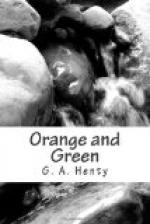The Irish had cut openings through the hedges by which they could retire, and, as they fell back from hedge to hedge, the advancing British were received by a fire from hedges on both flanks, as well as from the front. As the British poured regiment after regiment to the attack, Saint Ruth moved some bodies of horse and foot, from his left, to the support of his right wing.
This movement had been foreseen by Ginckle, who now gave orders for several battalions of infantry to cross the bog, and attack the Irish centre. At this point there was a path across the bog, or rather a place where the mud and water were not so deep as at other points, and where it was possible for it to be forded. Ginckle had found a peasant, who, for a large sum of money, disclosed the passage. It traversed the bog at its narrowest point, the hill of Kilcomeden here running out a shoulder far into it. Four regiments entered the morass, with orders to cross it, and make their way to the nearest hedges on the sloping ground, where they were to post themselves till the cavalry, who were to attempt the passage by Aughrim Castle, could come round to their support.
The first part of the passage was unopposed, but the difficulty of passing was great, for the men were frequently up to their waists in mud, too soft to afford any firm footing, but solid enough to render it extremely difficult for the feet to be disengaged from it. At length, as they approached firmer ground, the Irish infantry advanced towards the edge of the bog, and received them with a steady fire. The English, although suffering heavily, pressed forward without firing a shot, till the ground became solid under their feet, when the Irish withdrew, and, as upon the right, took post behind the hedges which everywhere intersected the slopes.
The English, seeing the Irish retire, pressed forward, and another fierce contest raged in the inclosures; the Irish, according to their preconceived plan, falling gradually back. The British, in their ardour, forgot their orders to halt at the first hedge, and continued to press forward, until the constantly increasing numbers of the enemy recalled to their leaders the danger of the position.
Before them were the heights of Kilcomeden, with a strong force drawn up to receive them, while on both flanks the enemy were crowding down, to intercept their retreat. Colonel Earl, who was the senior officer, looked anxiously towards the right, from which quarter he expected the British cavalry to arrive to his assistance; but no sound reached him from that quarter; while on the left the sound of the conflict, instead of advancing, appeared to recede, as if the British column was being forced back. Advancing before his own regiment, he called upon the soldiers to stand firm, for retreat would be destruction, and the only hope was to maintain their position till assistance arrived.
When the Irish saw that the enemy had halted, and could not be tempted to advance further, they poured down to the attack through the passages in the hedges. The British might have defended these hedges, as the Irish had done, but the soldiers saw that they would be taken in the flank and rear, and, observing a large body of cavalry ascending the hill, they were seized with a panic.




